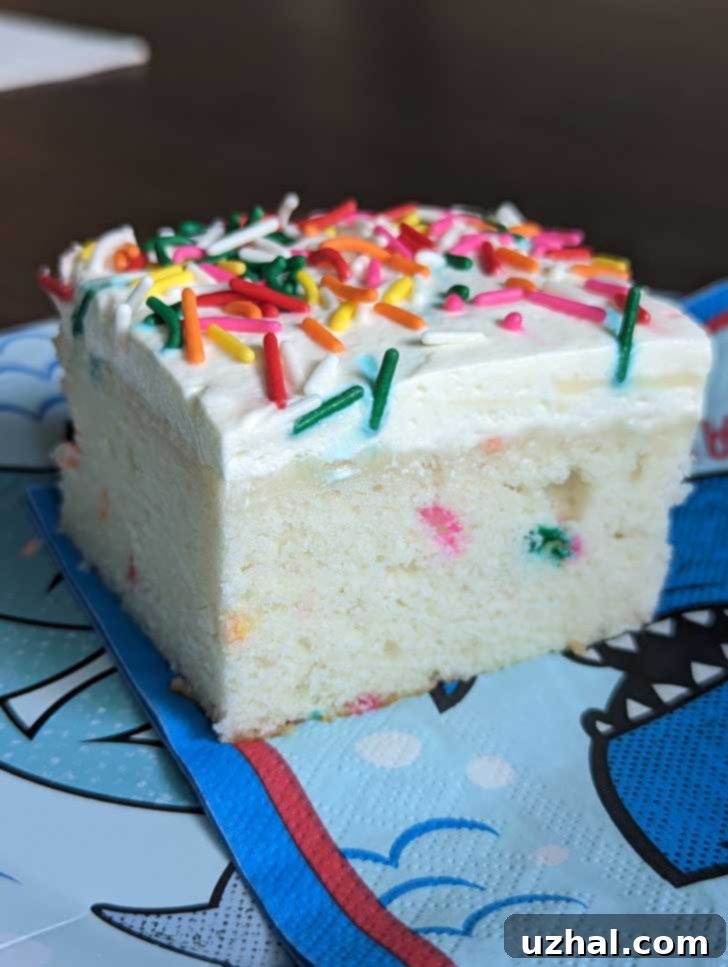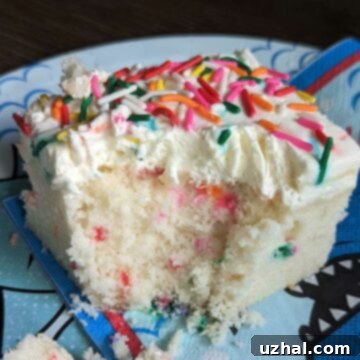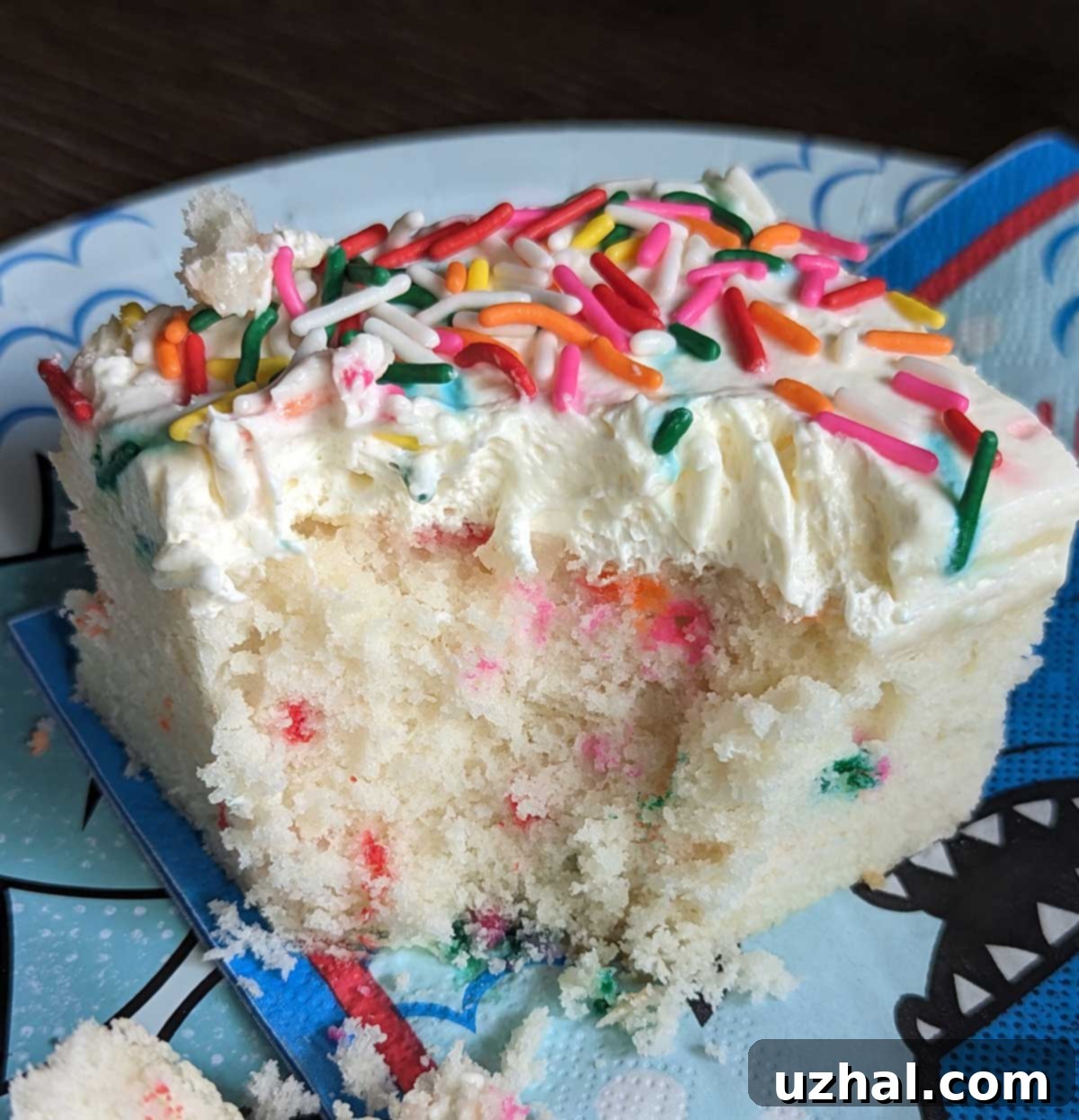The Ultimate Square White Cake Recipe: Perfectly Moist, Fluffy & Easy to Bake
Embarking on a quest to discover “the best” white cake recipe has been a delightful culinary journey, and this particular rendition stands out as a true gem. This isn’t just any white cake; it’s a meticulously adapted recipe designed to deliver a genuinely white crumb, infused with the classic, comforting aroma of pure vanilla and a subtle hint of almond extract. Unlike many recipes that might lean towards a yellow hue, this one proudly maintains its pristine white appearance, making it perfect for elegant celebrations or simply brightening an ordinary day.
Originally inspired by the expert bakers at Zoey Bakes Cakes, this version has been thoughtfully scaled and tailored for convenience, making it ideal for home bakers. My primary modification was to halve the original recipe, transforming it into a perfect fit for a standard 8-inch square pan. This adjustment makes the cake incredibly versatile, whether you’re baking for a smaller gathering, testing out a new recipe, or simply prefer the practicality and charming aesthetics of a square cake. The square shape also simplifies serving, allowing for neat, even slices. I’ve affectionately dubbed it the “Square Pan White Cake” – a name that not only reflects its new form but also helps me easily locate this tried-and-true favorite for future baking endeavors. Get ready to experience a truly exceptional white cake that’s both manageable to bake and utterly delightful to savor.

Unveiling the Exquisite Texture and Flavor Profile
This Square Pan White Cake offers a fascinating and distinct texture that sets it apart from other contenders in my search for the ultimate white cake. When you cut into it, you’ll immediately notice its remarkably tighter crumb. This isn’t to say it’s dense; rather, it indicates a finely structured interior that feels incredibly soft and velvety on the palate. Compared to the more open and airy crumb of a Betty Crocker Silver White Cake or even the slightly coarser texture of a Butter White Cake, this recipe achieves a refined elegance that melts in your mouth.
Richness, Sweetness, and the Iconic Vanilla-Almond Duo
Beyond its unique texture, this white cake boasts a richer flavor profile that truly elevates the experience. While undoubtedly sweet, it’s a balanced sweetness that doesn’t overwhelm, allowing the delicate nuances of the vanilla and almond extracts to shine through. The combination of vanilla and almond is a classic in white cakes for good reason; the smooth, comforting warmth of vanilla harmonizes beautifully with the slightly nutty, fragrant notes of almond, creating a sophisticated and memorable taste that evokes a sense of nostalgia and celebration. Every bite is an exquisite blend of these two beloved flavors, making it universally appealing for various occasions, from birthdays to simple family desserts.
The Secret to its Pristine Whiteness: A Buttermilk Alternative
To achieve this cake’s distinctive whiteness and tender crumb, I employed a clever substitute for traditional buttermilk. Instead of ¼ cup of buttermilk, I used a mixture of 3 tablespoons of plain nonfat yogurt and 1 tablespoon of whole milk. This improvisation proved to be a stroke of genius. Buttermilk is often used in cakes for its acidity, which reacts with baking soda to create lift and tenderness, but it can sometimes impart a slightly off-white hue. My yogurt and milk blend delivered the necessary acidity and moisture without compromising the cake’s pure white color. It successfully mimicked the tenderizing effects of buttermilk while maintaining the cake’s visual appeal. I would absolutely use this combination again, as it consistently helps to keep the cake a stunning, bright white, ensuring it lives up to its “white cake” moniker in every way.
Choosing the Best Frosting for Your White Cake
The perfect frosting can truly elevate a white cake, turning it from a simple dessert into a show-stopping masterpiece. A harmonious pairing of cake and frosting is essential, and with a cake as delicate and flavorful as this Square Pan White Cake, you want a frosting that complements without overpowering.
Navigating Frosting Choices: From Necessity to Perfection
During my initial bake of this square white cake, I found myself in a common baking predicament: out of confectioners’ sugar! Necessity being the mother of invention, I resorted to my trusty Pudding Mix Frosting. While it’s undeniably a delicious option – wonderfully creamy and flavorful – it does have a significant drawback: it requires refrigeration. This makes it fantastic for scenarios where the cake will be consumed quickly, such as ice cream cakes or cakes that only need to be displayed for a couple of hours. However, for a classic white cake destined for a longer display or warmer conditions, it’s not the ideal choice. Its need for constant chilling limits its practicality for many celebratory settings. Therefore, for the Square Pan White Cake, it’s best to consider more stable and versatile frosting options.
Recommended Frostings for the Square White Cake
To truly do this Square Pan White Cake justice, your best bet is to pair it with a classic, stable frosting that can stand up to room temperature for extended periods. Here are some top recommendations:
- American Buttercream: A good American Buttercream is a fantastic choice. It’s simple to make, holds its shape well, and offers a delightful sweetness that perfectly balances the cake’s vanilla-almond notes. Its rich, creamy texture is a crowd-pleaser and can be easily flavored or colored to match any occasion. It’s stable, pipes beautifully, and is generally forgiving for novice and experienced bakers alike.
- Swiss or Italian Meringue Buttercream: For those seeking a less sweet, more luxurious option, Swiss or Italian Meringue Buttercreams are excellent. These frostings are known for their incredibly smooth, silky texture and lighter mouthfeel, thanks to the meringue base. They are more involved to prepare but yield a professional, elegant finish that is both stable and less prone to cloying sweetness. The delicate nature of these buttercreams wonderfully complements the subtle richness of the white cake without overwhelming it.
- Cornstarch Frosting: I’ve been considering my Cornstarch Frosting for the next time I bake this cake. It’s a less sweet buttercream that has gained a lot of popularity for its unique texture and balanced flavor. It’s creamy and pipes well, offering a wonderful alternative for those who prefer their desserts not to be overly sugary.
- German Buttercream: Another contender on my list is German Buttercream. This custard-based frosting is incredibly rich, smooth, and velvety. It has a distinctive flavor profile that could add another layer of complexity to the white cake, creating a truly gourmet experience. Its robust texture makes it an excellent choice for piping and decorating.
The world of frostings is vast and exciting, and with so many delightful options to choose from, you can customize your Square Pan White Cake to suit any preference or occasion. Next time, I plan to experiment further, as the possibilities are endless for creating that perfect cake and frosting combination!
Essential Baking Tips for a Flawless White Cake
Achieving a truly remarkable white cake goes beyond just following the recipe; it involves understanding some fundamental baking principles. Here are some key tips to ensure your Square Pan White Cake turns out perfectly moist, fluffy, and vibrant white every time:
Ingredient Preparation is Key
- Room Temperature Ingredients: Always ensure your egg whites and dairy (yogurt/milk or buttermilk) are at room temperature. This is crucial for proper emulsification. Room temperature ingredients blend together more smoothly and evenly, creating a uniform batter that traps air more efficiently, resulting in a lighter and fluffier cake. Cold ingredients can cause the batter to curdle or become lumpy.
- Softened Butter (But Still Cool): The recipe calls for softened butter, but it’s important that it’s “fairly cool.” This means it should be pliable enough to press an indentation with your finger, but not greasy or melted. Butter that is too soft won’t cream properly, which is essential for incorporating air into the batter.
The Art of Mixing
- Sifting Cake Flour: Sifting the cake flour, especially multiple times as suggested, is not merely a formality. Cake flour has a lower protein content, which contributes to a tender crumb, and sifting helps to aerate it further, removing any lumps and ensuring it’s evenly distributed throughout the batter. This results in a finer, more delicate cake texture.
- Creaming Butter and Sugar: The creaming process – beating the butter, shortening, and sugar until creamy – is vital. Continuing to beat and scrape the bowl for about 5 minutes as directed ensures that enough air is incorporated into the fat and sugar mixture. This creates tiny air pockets that expand during baking, contributing significantly to the cake’s lift and airy texture. Don’t rush this step!
- Gradual Egg White Addition: Adding egg whites gradually (in 4 to 6 additions) and scraping the bowl frequently allows them to fully emulsify with the creamed mixture. Beating for 20-30 seconds between additions helps maintain a stable emulsion, preventing the batter from breaking and ensuring a smooth, consistent texture.
- Alternating Flour and Liquid: When adding the flour and yogurt mixture, do so in three alternating additions. This method helps prevent overmixing, which can develop the gluten in the flour too much, leading to a tough, dry cake. Mix just until combined. If using a stand mixer, sometimes finishing this step by hand with a heavy-duty scraper is easier to ensure gentle mixing and prevent gluten development.
- Folding in Whipped Cream: The addition of whipped cream is a special touch that adds incredible lightness and tenderness to the cake. Gently fold it into the batter with a heavy-duty scraper to maintain the airiness of the whipped cream and prevent deflating the batter. This step significantly contributes to the cake’s delicate mouthfeel.
Perfecting the Bake
- Releasing Air Bubbles: The simple act of dropping the pan on the counter a couple of times from a half-inch height helps release any large air bubbles trapped in the batter. This prevents large holes in your finished cake, ensuring an even, uniform crumb.
- Checking for Doneness: Baking time is always an estimate. Rely on visual cues: the cake will appear slightly golden brown around the edges, and the center will no longer look wet or too pale. A wooden skewer inserted into the center should come out clean. Avoid overbaking, as this is a common cause of dry cakes.
- Cooling Process: Allowing the cake to cool completely in the pan initially (or for about 10 minutes before turning it out) is important. This helps the cake to set and prevents it from crumbling when handled. Frosting a warm cake is a common mistake that leads to melted frosting and frustration!
By paying attention to these details, you’ll be well on your way to baking a truly exceptional Square Pan White Cake that is as beautiful as it is delicious. Happy baking!
A special thanks to Sue for her valuable recommendation of this delightful recipe! For those who prefer a traditional three-layer cake, you can find the full, original recipe in the inspiring cookbook Zoey Bakes Cakes. It’s a wonderful resource for any baking enthusiast.
- Chocolate Pudding for Two
- Coconut Pudding Cookies
- Milk Chocolate Pudding
- White Chocolate Chunk Lemon Pudding Cookies
- Instant Pudding Mix Oatmeal Cookies
Recipe

Square White Cake
Anna
Pin Recipe
Ingredients
- 1 ½ cups cake flour (170 grams, essential for a tender crumb)
- 1 teaspoon baking powder
- ¾ teaspoon salt (Morton kosher)
- 3 tablespoons nonfat plain Greek yogurt**
- 1 tablespoon whole milk (14 grams)
- 1 ½ teaspoon vanilla plus ¼ teaspoon almond extract (for that classic white cake flavor)
- 4 tablespoons unsalted butter, softened but still fairly cool (56 grams)
- 3 ½ tablespoons shortening (40 grams, contributes to tenderness and white color)
- 1 cup granulated sugar (200 grams)
- ½ cup egg whites, room temperature (from 3 large eggs, crucial for true white color)
- ¼ cup plus 2 tablespoons heavy whipping cream
- 2-3 tablespoons sprinkles (optional, for a festive touch)
Instructions
-
Preheat your oven to 350°F (175°C). Prepare an 8-inch square metal baking pan by thoroughly greasing it. For easy removal, you may also line the bottom with parchment paper after greasing, then grease the parchment too.
-
Sift the cake flour once to aerate it. Then, in a medium bowl, sift or whisk together the sifted cake flour with the baking powder and salt. If any salt remains in the sifter, simply stir it into the mixture by hand to ensure it’s fully incorporated. This step helps create a lighter, more even crumb.
-
In a small separate bowl, combine the nonfat Greek yogurt, whole milk, vanilla extract, and almond extract. Stir well until thoroughly blended. Set this liquid mixture aside for later use.
-
In the bowl of a stand mixer fitted with the paddle attachment, beat the softened butter, shortening, and granulated sugar together. Start on medium speed and continue beating until the mixture is light, fluffy, and creamy. This creaming process should take approximately 5 minutes, ensuring you scrape down the sides of the bowl frequently to incorporate all ingredients evenly. This step is crucial for incorporating air and achieving a light texture.
-
With the mixer running on low speed, gradually add the room temperature egg whites. Introduce them in about 4 to 6 small additions, allowing each addition to fully incorporate before adding the next. Remember to stop the mixer and scrape down the bowl between each addition, beating for 20-30 seconds after each scrape to ensure everything is well combined and emulsified.
-
Reduce the mixer speed to medium-low, or complete this step by hand with a heavy-duty scraper to avoid overmixing. Add the dry flour mixture and the wet yogurt mixture in three alternating additions, beginning and ending with the flour. For instance, add about a third of the flour mixture, mix gently until just combined, then add half of the yogurt mixture, mix gently, then another third of the flour, the remaining yogurt, and finally the last third of the flour. Scrape the sides of the bowl frequently to ensure everything is evenly incorporated without overdeveloping the gluten.
-
In a separate, clean bowl, whip the heavy cream until soft peaks form, using a handheld mixer or whisk. Gently fold this whipped cream into the cake batter using a heavy-duty scraper. Be careful not to deflate the batter. This step adds an extra layer of lightness and moisture. For a festive touch, now is the time to fold in your optional sprinkles – they look absolutely beautiful in this pure white cake!
-
Pour the prepared cake batter into your greased 8-inch square pan. To release any trapped air bubbles, gently drop the pan onto your kitchen counter from a height of about ½ inch, repeating this action twice. This helps ensure an even, uniform crumb in the finished cake.
-
Bake the cake in the preheated oven for approximately 30 minutes. Baking times can vary, so monitor for visual cues of doneness: the edges will appear slightly golden brown, and the center will no longer be quite as pale or wet-looking. A wooden skewer inserted into the center should come out clean. Once baked, let the cake cool completely in the pan on a wire rack. For convenience, you can frost it directly in the pan. Alternatively, if you prefer to frost it outside the pan, allow it to cool in the pan for about 10 minutes, then carefully invert it onto a wire rack to cool completely before frosting. Ensure it’s fully cooled to prevent the frosting from melting.
Notes
